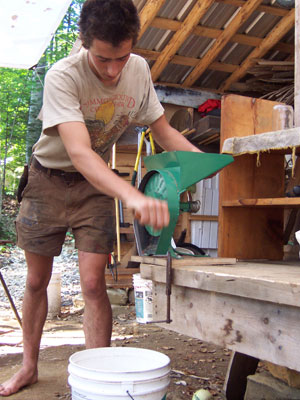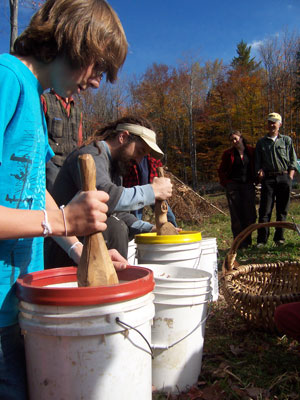 |
| Processing acorns in a Davebilt nutcracker. Photo courtesy of Chris and Ashirah Knapp. |
 |
By Chris Knapp
In autumn, all over the world, something wonderful happens: The acorns fall.
The oak seed, which once sustained the bulk of human civilization, is now largely ignored as a food. Not so at our Koviashuvik Local Living School, where every fall my family, friends, apprentices and I spend three wonderful mornings crawling around in the nearby red oak grove picking up acorns. We are not playing; we are making a living and playing.
This article offers a practical guide to processing acorns, a glance at the crop’s agricultural implications, and a chance to change the world – for as with any food or product, its conscious production and consumption create powerful opportunities for social and environmental change.
Using Acorns
My family eats acorns in a variety of ways and uses 200 pounds of acorn flour a year. All our acorns come from the red oak, Quercus rubra, as that is our local oak. All acorns – whether from red or white oaks – are edible and all acorns contain enough tannin that leaching is a necessity.
Our daily bread is a delicious blend of 60 percent acorn and 40 percent sourdough spelt from the Webb Family Farm in Pittston, Maine. We make acorn-oatmeal porridge twice a week for breakfast with 50 to 75 percent acorn. My kids, ages 4 and 2, eat it right up!
We make biscuits and cookies. I like a dense, 95 percent acorn flat bread held together with 5 percent soaked ground flax. For a basic biscuit recipe that will please anyone, combine 2 cups of acorn flour with 1 cup of oat flour, add 2 tablespoons of good fat and 1/2 teaspoon salt. (For fat we use Maine-grown sunflower oil or lard.) Add water to make a moist but not runny batter. Form the batter into biscuits and bake for 15 to 20 minutes at 375 F. Will Bonsall ate a whole bowl of these crackers when we shared them with him.
The Forest Garden
As a gardener who mulches religiously, I often look enviously at the forest floor. Mother Earth does the work herself there, as trees capture sunlight, create organic matter and feed the very soil in which they grow. This is a beautiful, closed nutrient cycle with a slight annual gain in fertility. Harvesting acorns removes only a tiny percentage of the organic matter; in fact, the acorn was meant to be given away as seed.
The forest is extremely efficient; it captures more solar energy and creates more organic matter than any other ecosystem. Even more efficient than using this organic matter to feed our garden (which we do) is to eat from the forest directly. Imagine what some of our forests would look like 200 years from now if acorn consumption were a goal of the management plan!
A Meaningful Process
The benefits of eating acorns go beyond efficiency. As I spend more and more time processing acorns, I find meaning in the process itself. In fact, each of the 10 steps below feels like a worthwhile activity in and of itself.
As I listen to presidential hopefuls make optimistic promises for social health, job security and economic prosperity, I think, “This is beyond the scope of your work. Only the people can create healthy communities, stable jobs and dependable food sources. This is our work, to be accomplished in countless daily interactions with each other and the land.”
 |
| Checking acorn meats for shell fragments. Photo courtesy of Chris and Ashirah Knapp. |
So let’s not wait for the politician’s help: Bend down and pick up an acorn!
Ten Steps for Making Acorn Flour
Warning: Eating acorns before completing step 9 will result in vigorous spitting and facial contortion! All bitter tannins must be fully leached from acorns.
1. On a fine fall day, gather friends, family and as many kids as you can find, go into your local oak grove, bend down and pick up acorns.
2. Enjoy your walk home, or to the car. Enjoy the weight of the acorns on your back; that weight is the promise of health and food security. When you arrive home, spread your acorns on screens to dry. An acorn is fully dry when, upon cracking, the shell pops and the meat, now hard and contracted, falls away from the shell. We place eight screens in the rafters of our 10- by 14-foot cabin. Because we heat and cook with wood, the acorns dry in just two to three weeks. Don’t be discouraged if it takes as long as six weeks. We also pre-dry acorns in large cedar cold frames with wooden bottoms. This is a slow process in the October and November sun but speeds the rotation of acorns in the house.
3. Place a thin layer of dry acorns in the bottom of a strong vessel and pound with a wooden mallet until all the acorns look cracked but not pulverized. A 5-gallon bucket with a wooden disc in the bottom works well. Sing your favorite rhythmical song while you pound! A hand-crank nut sheller called the Davebilt will save you hours. It’s available from Davebilt Co. (www.davebilt.com) in California. We use the Davebilt now but did the pounding method for years.
 |
| Lacking a nut sheller, acorns can be pounded in a bucket with a wooden disc in the bottom. Photo courtesy of Chris and Ashirah Knapp. |
4. Pour the pounded acorns into a bucket of water. The nutmeats sink and the shells float. Scoop off the shells with a colander, repeat step 3 and 4 and keep on singing.
5. Pour off the water and dry the acorn meats on screens. This drying will take only a day as the shells have been removed and the meats were already dry.
6. Invite someone over with whom you really want to talk. Pour the dry nutmeats onto a 1/4-inch mesh screen suspended an inch above the table and pick out the 5 percent of shell fragments that sank with the meats. Tiny shell fragments and some meat fragments will fall through the screen. Don’t stress; the screen makes shell picking much more efficient, and the little lost through the screen can be gifted to the squirrels.
7. Grind the acorns into flour in a Corona grain mill or some other grinder. Our Corona has had 12 years of steady use and now actually grinds a finer flour as the somewhat coarse plates have worn away. We screen our flour and regrind the grits to ensure consistent fineness.
8. Place a fine mesh cloth (a maple syrup pre-filter works well) inside a large colander, mix the flour with water to create a loose batter, pour the batter into the colander, place the colander under the tap (we use rain barrels) and turn on the water just a crack. Let the water flow slowly through the submerged flour for 12 hours or until all bitterness is gone. Stir occasionally.
9. Remove the flour and squeeze out the extra water through a clean T-shirt. In your favorite bread recipe, replace 25 to 75 percent of the flour with the leached acorn flour. Make the bread and bake it. It will not be your old favorite bread, but it will be your new favorite bread: dense, nutty and full of goodness.
10. Invite friends or family to the table and sit down and eat hot bread. This is not just bread, this is sustainable agriculture, homemade music, good exercise, time spent with friends and time spent outdoors. Enjoy your bread; you are creating a new world!
Chris and Ashirah Knapp offer classes in traditional and sustainable living skills at their Koviashuvik Local Living School in Temple, Maine – including an acorn class on October 6 from 10 to 3 (see www.koviashuvik.com). Look for the Knapps’ workshops in the Folk Arts Area at the Common Ground Country Fair.
